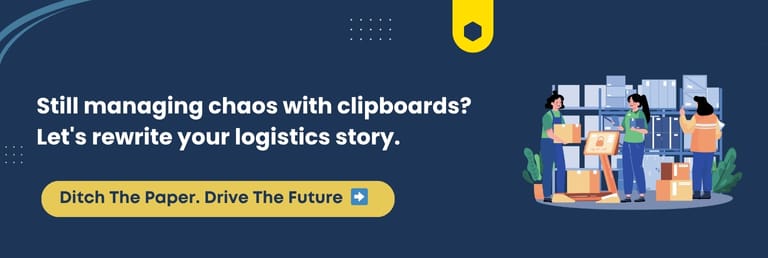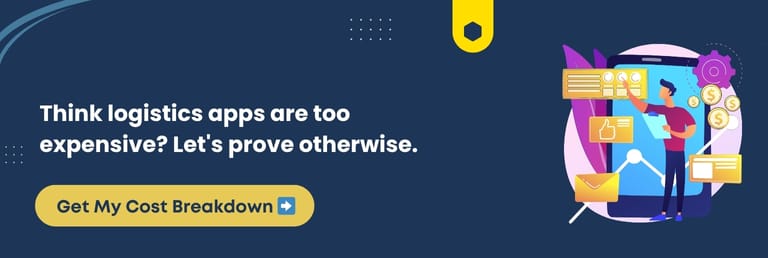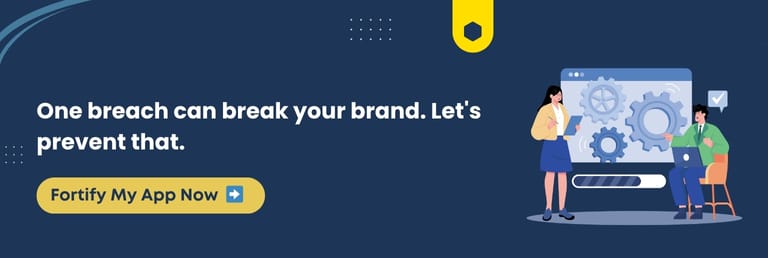Logistic App Development Guide 2025: Benefits, Challenges, Costs, & Steps
Keyur Patel
September 12, 2025
33 min
You will be surprised to know that in 2024 alone, the supply chain disruptions increased by nearly 38% compared to the previous year. The reasons behind this can be numerous.
For instance, a single late shipment can ripple through an entire supply chain, triggering missed deadlines, customer frustration, and unexpected costs. The repercussions of a delayed delivery cost are more than the time.
The biggest winners are those embracing mobile technology. If your business is still relying on spreadsheets, outdated software, or disconnected systems, you are sending invitations to logistics inefficiencies.
Hence, we have curated this blog to help you overcome these challenges and thrive in this rapidly evolving logistics industry.
This blog is your complete guide to logistics app development in 2025. It is designed for logistics managers, startups, fleet operators, and enterprise leaders who are ready to future-proof their operations.
Our purpose is simple: to give you a clear, insightful path to understanding what goes into a logistics app, how it can transform your business, and why now is the best time to build one.
Ready to move from reactive operations to real-time control? Let’s explore what your logistics future could look like.
Why Logistics Businesses Need A Mobile App In 2025
In today’s logistics landscape, speed and accuracy are primary expectations. Whether it’s last-mile delivery, freight coordination, or warehouse dispatch, relying on disconnected systems or outdated software invites costly delays and frustrates customers.
If your business is still juggling spreadsheets, calls, and manual updates, it’s time for a serious upgrade. The answer lies in mobile technology that brings every moving part of your logistics workflow into one intelligent platform.
Logistics: From Clipboards To Code
Logistics has always been complex, but how companies manage it has drastically changed. Just a few years ago, paper checklists, clipboards, and basic desktop systems were standard. But in the current fast-moving environment, they are holding businesses back.
Manual entries lead to errors, latency, and miscommunication between warehouses, drivers, and customers. These inefficiencies affect revenue and hinder customer satisfaction.
Mobile apps are solving this. A logistics app puts scheduling, tracking, proof of delivery, and team communication into one real-time platform that’s always accessible.
Whether you’re managing five trucks or fifty warehouses, the ideal app removes bottlenecks and keeps operations smooth.
What’s Changing In Supply Chains?
The supply chain is being reshaped by speed, visibility, and automation. The following are the major shifts:
- Customer expectations: Same-day or next-day delivery is now the norm.
- Rising costs: Fuel, labor, and warehousing costs continue to climb.
- Complexity: More third-party carriers, micro-fulfillment centers, and cross-border rules.
- Data demand: Real-time tracking and performance insights are now expected.
- Labor shortages: Tech is replacing repetitive manual tasks to keep things moving.
For small businesses, logistics apps level the playing field. For large enterprises, they create scale and precision.
What You Should Know: In 2025, a logistics app isn’t just about convenience. It’s a powerful tool that helps businesses simplify workflows, reduce costs, and meet growing delivery demands without falling behind their tech-driven competitors.
What Is Logistics App Development, And How Does It Differ From Traditional Software
In 2025, logistics app development has moved far beyond building just another tracking tool. It is now a critical business strategy that enables real-time visibility, automation, and control across the supply chain.
Unlike traditional software systems that are often rigid, hardware-bound, or siloed, logistics apps offer remarkable agility, scalability, and intelligent workflows through the latest mobile and cloud-based technologies.
Let’s break down what logistics app development really means today and how it differs from conventional ERP or transport systems.
Definition And Scope In 2025
Logistics app development refers to the creation of mobile-first platforms that manage transportation, inventory, deliveries, and warehouse operations in real-time. These apps are custom-built or modular, allowing businesses to digitize everything from driver dispatch to customer updates.
In 2025, the scope goes further:
- Real-time delivery updates
- Predictive analytics for route optimization
- Integrated communication between teams
- Mobile dashboards for performance monitoring
- API-ready systems for third-party integrations
How It Differs From Traditional ERP Or Transport Software
Traditional software systems, like legacy ERP or desktop transport software, often require expensive on-premise servers and manual data entry. They are designed for internal management and are slow to adapt to rapid changes.
In contrast, logistics apps are:
- Mobile and cloud-based: Access anywhere, anytime
- Modular and flexible: Add features as the business scales
- Real-time: Instant updates for customers, drivers, and managers
- Low maintenance: Faster upgrades and lower IT costs
They are built with a user-first mindset, offering clean interfaces and quicker workflows that match how teams operate in practicality today.
Types Of Logistics Apps
Not all logistics apps serve the same purpose. Based on business goals, here are the typical categories:
| App Type | Purpose | Key Features | Best For |
| Freight Management | Streamlines freight booking, shipment tracking, and documentation handling. | Load scheduling, freight matching, eBOL (electronic bill of lading), and dispatch coordination. | Carriers, 3PLs, shipping companies |
| Supply Chain | Offers end-to-end visibility and control over inventory and vendor flow. | Inventory tracking, demand forecasting, supplier integration, and multi-location management. | Manufacturers, wholesalers, distributors |
| On-Demand Delivery | Optimizes last-mile delivery for quick, real-time customer service. | Real-time GPS tracking, proof of delivery, notifications, and customer feedback tools. | E-commerce, grocery, and courier services |
| Fleet Management | Helps monitor vehicles, routes, driver behavior, and fuel efficiency. | GPS tracking, route history, fuel logs, driver analytics, vehicle diagnostics. | Logistics companies with owned/leased vehicles |
Each type serves specific pain points but shares one goal of making logistics operations savvier and more responsive.
Core Insight: Modern logistics app development in 2025 goes beyond old-fashioned software systems. It delivers flexibility, real-time insights, and efficiency through mobile-first tools that adapt to the changing needs of supply chains.
Market Outlook: Why It’s The Right Time To Invest In Logistics App Development
The logistics industry is in the middle of a rapid digital transformation. As demand for speed, accuracy, and efficiency rises, logistics businesses that fail to digitize risk falling behind. Hence, logistics app development is paramount for staying relevant and responsive in 2025.
Whether you’re a growing startup or an established enterprise, the timing couldn’t be better to invest in cutting-edge logistics app solutions. Here’s why.
Industry Growth Projections
The global logistics market is projected to reach over $16 trillion by 2032, and mobile technology is a significant growth driver. Mobile apps are enabling real-time supply chain management, faster delivery models, and automation at scale.
In 2025 alone, logistics app usage is anticipated to grow at an estimated CAGR of 9.1%.
It clearly indicates that more businesses are shifting to digital platforms to meet rising customer expectations, regulatory demands, and operational efficiency targets.
SaaS vs. Custom Apps: Key Trends
Present-day businesses are choosing between ready-to-use SaaS logistics platforms and custom app development, depending on flexibility, scalability, and data ownership needs.
| Factor | SaaS Logistics App | Custom Logistics App |
| Deployment Speed | Faster, ready-to-use | Slower, requires development time |
| Cost | Lower upfront, subscription-based | Higher upfront, long-term ownership |
| Scalability | Limited to the vendor’s roadmap | Fully scalable based on business needs |
| Customization | Limited features, fixed templates | Fully personalized to business workflows |
| Data Ownership | Controlled by a third-party provider | Total control over business data |
| Integration Flexibility | Limited integrations or a closed ecosystem | Seamless integration with internal systems and third-party tools |
| Best For | Startups and small businesses needing speed | Enterprises or growing companies needing flexibility and long-term ROI |
➡️Key Trend: Many logistics tech companies now follow a hybrid model, using SaaS foundations with customized layers for flexibility and control.
Success Signals: Who’s Winning With Apps?
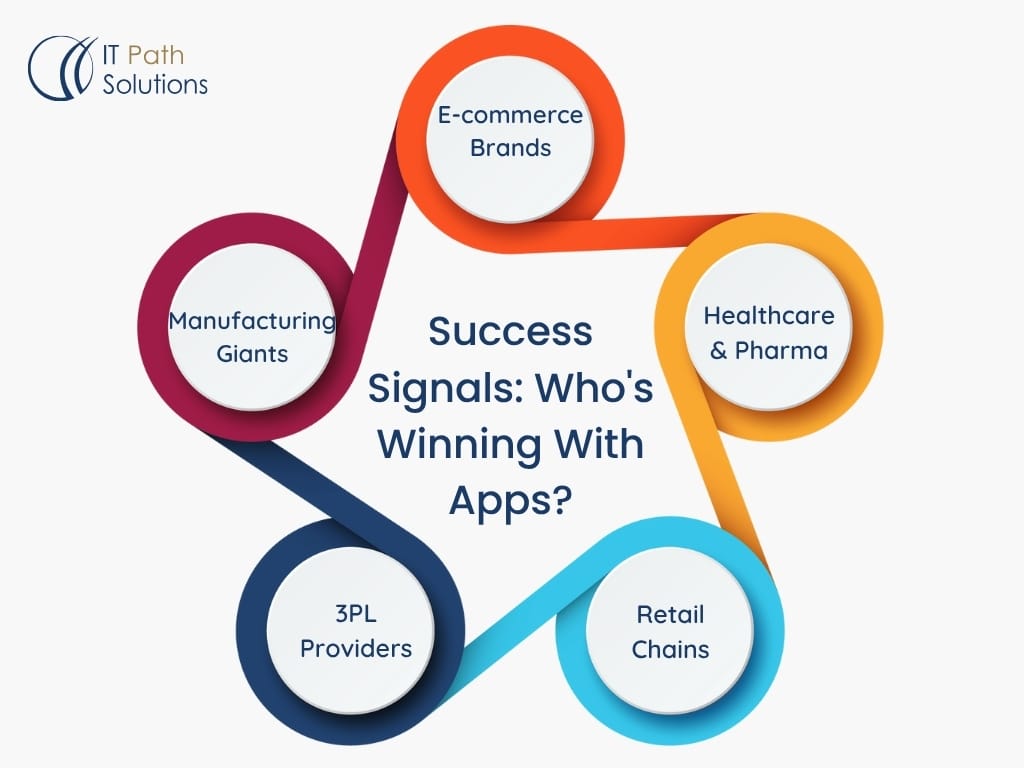
- E-commerce Brands: Companies like Amazon and Shopify, logistics partners use mobile apps for end-to-end shipment tracking, route optimization, and warehouse automation.
- Healthcare & Pharma: Cold chain tracking and compliance apps are ensuring temperature-sensitive deliveries remain compliant.
- Retail Chains: Logistics apps enable inventory syncing across locations, stock visibility, and delivery scheduling for multi-store operations.
- 3PL Providers: Third-party logistics firms are deploying apps for real-time client dashboards, driver dispatch, and contract freight automation.
- Manufacturing Giants: Factory-to-warehouse visibility, asset tracking, and supplier network monitoring are all managed through mobile-first apps.
These sectors are setting the benchmark and proving that app-led logistics isn’t just the future; it is the present.
What This Means For You: Logistics app development is no longer a trend; it is a must-have for growth. With industry momentum, proven ROI, and powerful use cases across multiple sectors, it is the wisest time now to digitize logistics operations.
Note: If you want to build a load planning software or are confused whether the other one is correct for you, we suggest referring to our other blog on load planning.
Key Benefits Of Logistics App Development For Businesses Of All Sizes
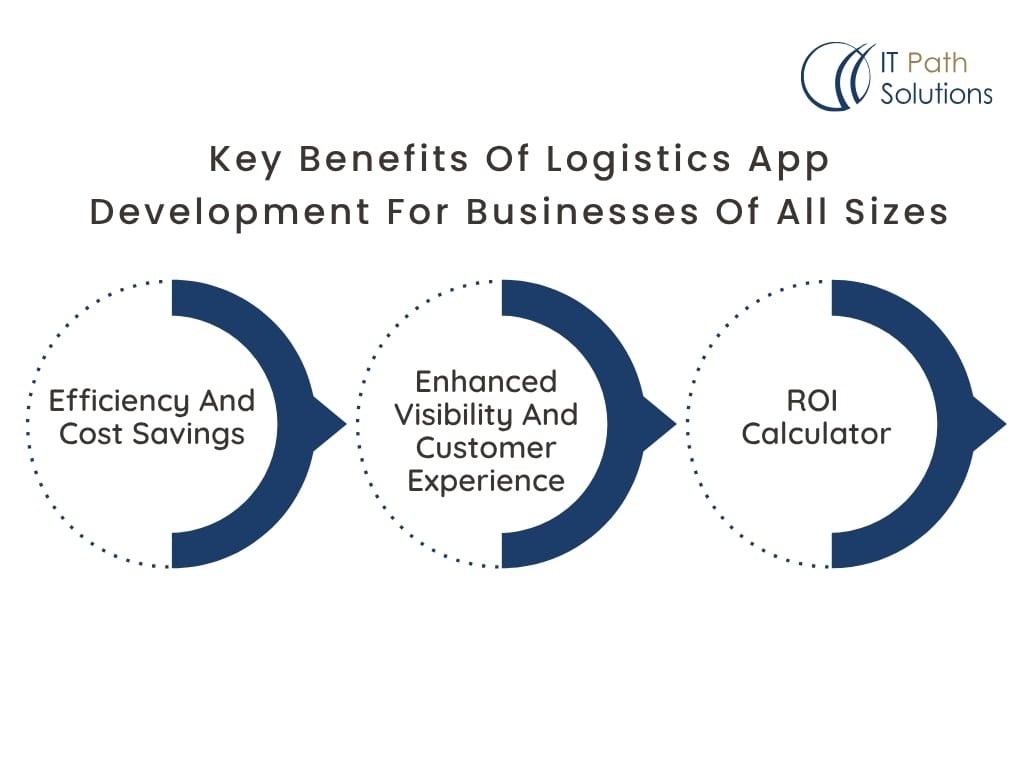
A logistics app is not just a digital add-on; it is a core business enabler. Whether you operate a small distribution firm or a global freight company, mobile logistics solutions can significantly:
- Improve the way your supply chain functions
- Cuts costs, and
- Delights customers.
From automating manual tasks to increasing delivery transparency, let’s explore the astonishing business benefits you can capitalize on with logistics app development in 2025.
Efficiency And Cost Savings
A custom logistics app eliminates redundant processes and streamlines everything from dispatch to delivery.
- Real-time updates cut down communication delays.
- Automated route planning reduces fuel usage and idle time.
- Digital proof of delivery replaces paperwork and speeds up invoicing.
➡️Businesses report up to 25 percent cost savings and 30 percent faster operations after digitizing logistics workflows.
Enhanced Visibility And Customer Experience
Customers today expect real-time tracking and proactive notifications. Logistics apps make this possible.
- GPS-based tracking gives comprehensive transparency into vehicle movements.
- Smart notifications keep customers informed at every step.
- Faster delivery windows build brand trust and retention.
For businesses, this also means fewer customer complaints, improved feedback loops, and stronger service-level agreements (SLAs).
ROI Calculator: What Can Logistics Apps Return?
A well-designed logistics app pays for itself in a short time. Let’s look at pivotal return areas:
| Area | ROI Impact |
| Fuel and route optimization | Up to 20 percent cost savings |
| Driver performance tracking | 15 percent boost in productivity |
| Real-time order visibility | 30 percent drop in delivery-related inquiries |
| Warehouse sync and automation | 25 percent improvement in throughput |
Spotlight: Logistics App For Small Businesses
Small businesses often hesitate to invest in tech due to budget concerns. However, logistics apps are no longer out of reach.
- Cloud-based solutions make deployment affordable.
- Modular features allow scaling at your own pace.
- Automation reduces dependency on manual labor, elevating output without increasing headcount.
For a small logistics company, even a fundamental app with GPS tracking, order scheduling, and digital PoD can significantly boost operations.
Main Message: Logistics apps unlock unmatched efficiency, heightened visibility, and stronger customer loyalty. Whether you’re running a fleet or managing last-mile deliveries, the business returns are measurable and transformative across all sizes.
Use Cases: Logistics App Development That Made A Real Impact
Knowing the potential of logistics apps is one thing. Seeing how they’ve transformed tangible businesses is another. The following case studies illustrate how logistics mobile app development can solve real-world challenges, drive results, and sometimes even rescue operations on the brink of failure.
From fleet optimization to warehouse tracking, these examples demonstrate the power of purposeful logistics tech in action.
Use Case 1: Fleet Optimization For A Regional Carrier
-
- Client Type: Regional transport company with 60+ vehicles
- Challenge: Improper route planning, excessive fuel use, and delayed deliveries
- Solution: A custom fleet management app with GPS tracking, real-time route updates, driver behavior monitoring, and traffic-aware routing
- Result:
-
- 22 percent reduction in fuel consumption
- 30 percent improvement in on-time delivery rates
- Increased customer satisfaction through live tracking and updates
Use Case 2: Real-Time Warehouse Tracking For An E-Commerce Supplier
-
- Client Type: Medium-sized e-commerce fulfillment company
- Challenge: Inventory errors, slow picking and packing, outdated barcode system
- Solution: Logistics mobile app integrated with barcode scanning, real-time stock visibility, and warehouse zone optimization
- Result:
-
- 40 percent faster order processing
- 99 percent inventory accuracy
- Seamless coordination between warehouse staff and delivery teams
Use Case 3: What Went Wrong – A Costly Failure and the Lessons Learned
-
- Client Type: Last-mile delivery startup
- Challenge: Adopted a white-label app without customization or scalability planning
- What Happened:
-
- The app couldn’t scale as delivery volumes grew
- Lack of backend control led to missed deliveries and customer churn
- Failed integrations caused data repositories and reporting issues
➡️Key Lesson: Without aligning your app’s capabilities with business needs, growth can expose your tech limitations quickly. This startup later pivoted to an entire custom logistics solution built from scratch.
The Bottom Line: Logistics apps are not theory; they’re in action. From optimized fleets to savvier warehouses, real businesses are already enjoying measurable success. The key is building a suitable logistics app for your operational needs and growth goals.
Must-Have Features In A Logistics App (Basic To Advanced)
A logistics app is only as effective as the features it offers. Whether you’re building a basic delivery solution or a full-fledged fleet and warehouse management system, the ideal set of features can determine operational success or failure.
This section walks through both foundational and high-end functionalities that the latest logistics apps in 2025 must include, with an eye on scalability and user experience.
Necessary Features Every Logistics App Should Include
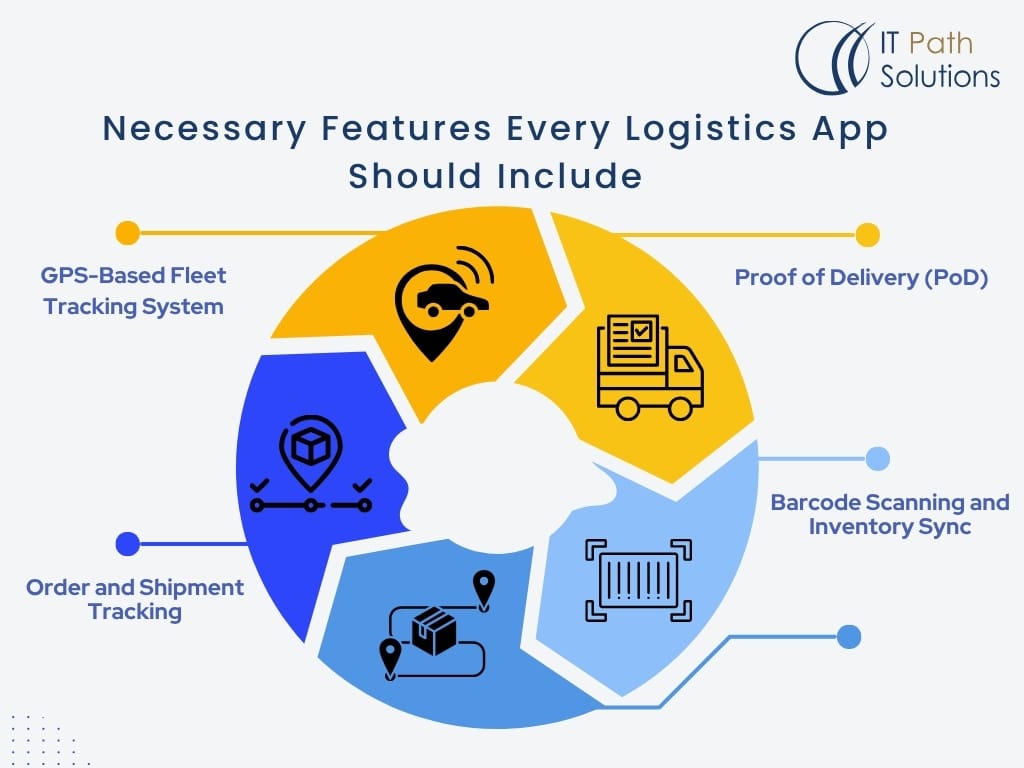
GPS-Based Fleet Tracking System
Real-time vehicle monitoring enhances visibility, safety, and routing efficiency.
Order and Shipment Tracking
Keeps customers and logistics managers updated on shipment statuses, improving transparency and trust.
Barcode Scanning and Inventory Sync
Fast, error-free scanning for inbound and outbound operations ensures accurate inventory management.
Proof of Delivery (PoD)
Drivers can upload signatures, photos, or notes directly into the app to confirm successful deliveries.
Advanced Features To Drive Competitive Advantage
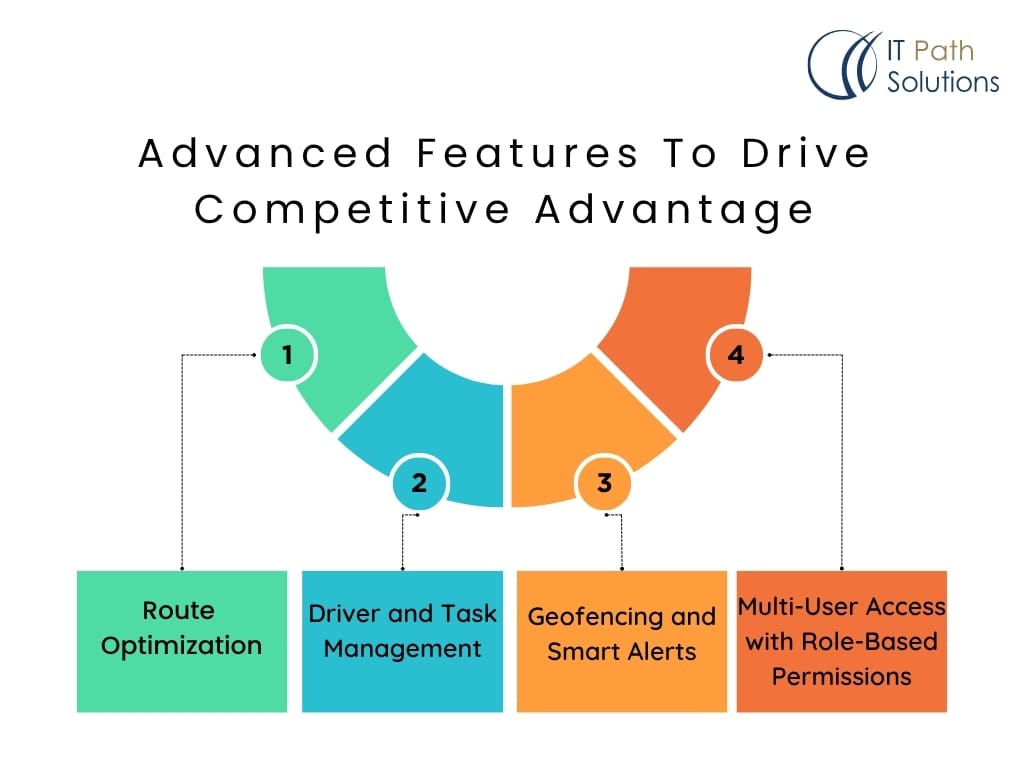
Route Optimization
AI-powered algorithms suggest the quickest and most fuel-efficient routes based on traffic, weather, and delivery priorities.
Driver and Task Management
Assign deliveries, monitor performance, and track compliance in real time from a centralized dashboard.
Geofencing and Smart Alerts
Receive automated updates when a vehicle enters or exits a defined area, helping with route compliance and delivery accuracy.
Multi-User Access with Role-Based Permissions
Provide different access levels for dispatchers, drivers, warehouse managers, and clients, thereby reinforcing operational security.
Industry-Specific Customizations
Diverse logistics verticals may need unique functionalities. For instance,
- E-commerce may prioritize real-time customer notifications and return logistics.
- Healthcare requires temperature tracking and compliance documentation.
- Freight or 3PL needs deep integration with partner systems, contract management, and digital documentation.
Note: Building flexibility into the app architecture is critical to meet such demands.
The Crux: A high-performing logistics app goes beyond basic tracking. It blends automation, user-specific features, and cutting-edge optimization tools that solve tangible problems while adapting to industry-specific needs.
Tech Stack, Integrations, And UX Behind High-Performing Logistics Apps
Every successful logistics app runs on a rock-solid foundation. From development frameworks and data architecture to seamless user interfaces and real-time integrations, your tech stack will either make or break the user experience.
Hence, all logistics businesses aiming to scale in 2025 must choose their architecture wisely to ensure flexibility, speed, and long-term value.
Native vs. Cross-Platform Development: What Should You Choose?
Deciding between native and cross-platform development is one of the earliest and most impactful decisions in logistics app development. Here’s a breakdown to help you compare the two paths side by side:
| Criteria | Native Apps (iOS or Android) | Cross-Platform Apps (Flutter, React Native) |
| Performance | High, optimized for platform-specific features | Moderate, may face slight performance trade-offs |
| Development Time | Longer due to separate codebases | Faster with a unified codebase |
| Cost | Higher initial cost | Lower upfront cost |
| Offline Functionality | Better offline handling and hardware integration | Available, but depends on framework capabilities |
| Maintenance | More effort due to dual codebases | Easier updates and fewer resource demands |
| Scalability | Ideal for large-scale apps with advanced functions | Good for MVPs and fast deployment cycles |
Backend Technologies And Data Infrastructure
Your backend is the operational brain of your logistics app. It powers everything from shipment updates to driver management. A potent, growth-friendly backend stack ensures real-time accuracy, meticulous data handling, and future readiness.
Cloud-Based Infrastructure
Cloud platforms like AWS, Google Cloud, and Azure offer elasticity, data resilience, and swifter load times. Logistics apps must be ready to scale as demand grows.
API Integration
A logistics app must speak fluently with ERPs, CRMs, GPS tracking systems, payment gateways, and e-commerce platforms. RESTful APIs make this integration rapid and flexible.
Database Management
Choose powerful and flexible databases like PostgreSQL, MySQL, or MongoDB to manage structured and unstructured logistics data. These databases offer high availability and robust querying.
UX Design That Drives Productivity
Even the most advanced logistics platform will fail if the user interface is clunky or confusing. A fascinating UX keeps users engaged and reduces training time, which is paramount for operational success.
Minimal Learning Curve
Users such as fleet managers, drivers, or warehouse staff should instantly know how to navigate the app. Keep interfaces simple and intuitive.
Role-Specific Views
Customize the user experience for dispatchers, drivers, warehouse personnel, and executives. It improves speed, accuracy, and satisfaction across all levels.
Offline Mode
Logistics often involves remote locations or unstable networks. Offline functionality with auto-sync bolsters performance in real-time delivery or inventory scenarios.
DevOps, CI/CD, And Testing Essentials
Delivering consistent performance under load and across updates requires a proactive approach to software lifecycle management.
Continuous Integration And Continuous Deployment (CI/CD)
Automating testing and deployments ensures speedier releases, fewer bugs, and seamless scaling.
Load Testing And Security Validation
Test your app’s performance under stress. Also, validate security protocols like encryption, role-based access, and threat detection systems.
Monitoring And Maintenance
Implement tools to monitor uptime, track usage patterns, and get alerts when performance dips.
Knowledge Drop: A logistics app is only as compelling as its architecture. Select a tech stack and development path that aligns with your business model, future scale, and operational needs while delivering exceptional usability across every user role.
Emerging Technologies That Are Transforming Logistics Mobile Apps
As logistics businesses race to meet the growing demands of real-time deliveries, predictive operations, and transparent supply chains, cutting-edge technologies are becoming the new engines of innovation.
In 2025, staying competitive means going beyond GPS and tracking. It means using intelligent, connected, and secure systems that continuously learn, adapt, and optimize.
From predictive AI to blockchain-backed security, logistics mobile apps are evolving into savvy logistics platforms. Below are the transformative technologies you should be paying attention to.
Real-Time AI For Predictive Logistics
Artificial intelligence is helping logistics companies predict demand spikes, optimize delivery routes, and minimize downtime. AI-powered logistics apps can forecast traffic, calculate the best delivery windows, and even suggest alternate transport modes in real time.
- AI reduces idle time and empty miles
- Helps avoid traffic and route delays
- Enables dynamic pricing and state-of-the-art inventory control
IoT For Vehicle And Cargo Monitoring
The Internet of Things enables real-time monitoring of goods, vehicles, driver behavior, and environmental conditions. Sensors placed on conveyances or packages can track location, temperature, vibration, and more.
- Real-time alerts for temperature-sensitive goods
- Monitor fuel efficiency, engine health, and driver safety
- Prevent losses by tracking assets across borders
Blockchain For Tamper-Proof Delivery Logs
Blockchain offers a secure and immutable way to log every transaction in the supply chain. It ensures transparency and traceability from origin to delivery, which is vital for industries like food, pharmaceuticals, and luxury goods.
- Prevents fraud, loss, or tampering
- Maintains clear audit trails for every delivery
- Boosts user trust and regulatory confidence
AR, VR, And Autonomous Integration: What’s Real In 2025?
While AR and VR are still emerging in logistics, they are already making an impact in warehouse management and driver training. Augmented reality helps pickers find items quickly, while virtual simulations improve safety training. Autonomous vehicles and drones are inching closer to practical reality.
- AR speeds up warehouse navigation
- VR reduces training costs and errors
- Autonomous delivery is in pilot across several urban centers
Must-Know Insight: In 2025, the future of logistics apps lies in intelligent automation and connected systems. Businesses that embrace AI, IoT, and blockchain today are building the competitive edge they will need tomorrow.
How Much Does It Cost To Develop A Logistics App In 2025?
When considering logistics app development, one of the foremost questions that comes to mind is cost. In 2025, app development pricing is influenced by the type of app, features, complexity, integrations, and compliance needs.
Whether you’re a startup looking to digitize operations or an enterprise upgrading from legacy software, knowing what to expect helps you plan better.
Let us break it down for clarity.
| App Type | Estimated Cost Range (USD) | Description |
| Basic Fleet Tracking App | 25,000 to 45,000 | Includes GPS, route planning, and delivery updates |
| Delivery or Courier App | 40,000 to 70,000 | Adds barcode scanning, PoD, and driver dashboard |
| Warehouse Management App | 60,000 to 90,000 | Inventory control, real-time alerts, stock reports |
| End-to-End ERP Logistics App | 100,000 to 200,000+ | Full supply chain integration, analytics, and automation |
Hidden Costs You Must Budget For
Cost is not limited to development alone. There are other pivotal areas to account for:
- Compliance: Meeting standards such as DOT, GDPR, or FDA can add legal and development overhead.
- Maintenance: Regular updates, bug fixes, and security patches average 15 to 20 percent of development cost annually.
- Third-Party Integrations: APIs, payment systems, telematics platforms, and CRM tools often require additional fees and dev time.
- Licensing and Infrastructure: Hosting, cloud storage, and analytics tools can have recurring charges.
Budgeting Tips For Startups And Enterprises
| Aspects | Startups | Enterprises |
| Goal | Launch quickly with core features | Build a scalable, feature-rich solution |
| Approach | MVP with cross-platform tech and open APIs | Custom build with high-end integrations |
| Budgeting | Focus on essentials and phased upgrades | Allocate for compliance, analytics, and long-term maintenance |
| Tools | Low-code platforms, cloud backend | Dedicated cloud, enterprise-grade tools |
| ROI Strategy | Quick wins and iterative scaling | Efficiency, automation, and strategic edge |
Main Point: Logistics app development in 2025 can range from affordable to premium, depending on the app type, features, and business scale. Knowing your needs and planning wisely helps avoid surprise expenses later.
Step-by-Step Logistics App Development Process And Timeline
Building a logistics app in 2025 requires more than just coding skills. It demands a strategic, well-phased process that ensures your app meets business goals, user expectations, and industry standards.
Whether you’re working with logistics mobile app developers for the first time or planning your second version, a well-thought-out roadmap makes all the difference.
Let us walk through each stage of the logistics app development process and what timeline you can expect at each step.
Step 1: Discovery And Scoping
This stage sets the foundation. Teams align on goals, target users, app type, required features, and expected outcomes. Competitive analysis, market research, and tech feasibility are part of this phase.
- Deliverables: Product brief, feature list, high-level architecture
- Timeline: 1 to 2 weeks
Step 2: UI/UX Design And Prototyping
User experience matters more than ever in logistics. This phase involves designing intuitive, role-specific interfaces and mapping out the user journey. Interactive prototypes allow for early testing and feedback.
- Deliverables: Wireframes, clickable prototypes, brand elements
- Timeline: 2 to 3 weeks
Step 3: Frontend, Backend, And API Development
Now your app takes shape. Developers build the app’s frontend for mobile or web, set up secure backends, and connect to third-party systems through APIs. It is where the majority of functionality is created.
- Deliverables: Codebase, integrations, cloud infrastructure
- Timeline: 4 to 8 weeks
Step 4: Testing, Deployment, And Support
Thorough testing includes functional, performance, security, and user acceptance testing. Once stable, the app is deployed to production. Post-launch support covers maintenance, monitoring, and iterative updates.
- Deliverables: QA reports, release version, support roadmap
- Timeline: 2 to 4 weeks
Quick Recap: A successful logistics app in 2025 follows a proven, step-by-step development process. From planning to deployment, each phase brings your vision closer to reality while minimizing costly rework and delays.
Custom vs White-Label Logistics Apps: Which One Should You Choose?
Determining between a custom logistics app and a white-label solution can significantly shape your logistics operations. The decision depends on your business size, goals, timeline, and scalability needs.
In this section, we will explain both options, when each makes sense, and how to find a balance when needed.
Moreover, we have a bonus for you. Some businesses combine white-label app solutions with custom modules or API integrations. For example, using a white-label platform for dispatch but integrating a custom-built analytics dashboard or client portal. This hybrid approach helps balance speed, cost, and customization.
The following is a side-by-side hybrid option, along with the other two, for better clarity:
| Criteria | White-Label Logistics Apps | Custom Logistics Apps | Hybrid Options |
| Overview | Pre-built platforms ready for branding and quick deployment | Fully tailored apps built from scratch for unique needs | A mix of pre-built core with custom integrations or modules |
| Best Suited For | Startups, small logistics firms, and quick launches | Enterprises, complex operations, and scalability-focused businesses | Mid-sized companies looking for balance |
| Time to Market | Fast (weeks) | Longer (months) | Moderate |
| Cost | Lower upfront cost | Higher initial investment | Flexible, depending on what is customized |
| Customization Level | Limited | Full | Partial (custom dashboards, reporting, client portals) |
| Scalability | May hit limits as business grows | Highly scalable | Can scale selectively |
| Vendor Dependency | High (vendor lock-in likely) | None (you own the code and infrastructure) | Medium (depending on the base platform) |
| Brand Identity | Generic branding with limited UI/UX control | Full branding control | The core platform may be generic, but extensions can reflect your brand |
| Security & Compliance | Basic, depends on the vendor | Stronger control can meet specific regulations | Depends on what’s custom-built |
Smart Summary: If you need speed and budget control, white-label apps are a great starting point. If you seek complete control and long-term scalability, a custom logistics app is your best bet. Some businesses thrive with a clever mix of both.
Common Challenges In Logistics App Development And How To Overcome Them
Developing a logistics app may seem straightforward. However, in reality, it brings a unique set of challenges. From security flaws and integration issues to performance bottlenecks and regulatory hurdles, the path is filled with complexities demanding strategic foresight.
Let’s break down the most typical logistics app development challenges and how to navigate them with savvier, practical solutions.
Security Gaps And Compliance Issues
As logistics apps handle sensitive data like customer locations, delivery schedules, and inventory levels, weak security measures can expose your business to significant risks. Moreover, failure to meet regulatory compliance, such as GDPR, ISO, or DOT requirements, can result in penalties and lost trust.
- Solution: Implement secure logistics app development practices from day one. Use end-to-end encryption, secure APIs, role-based access, and regular security audits. Always align your tech stack with current regulatory requirements.
Integration With Legacy Systems
Most logistics firms already use some form of ERP, TMS, or warehouse management tools. Improper integration between the new app and existing systems often leads to a piling up of data and workflow disruptions.
- Solution: Choose flexible APIs and ensure your logistics mobile app development company has experience handling API integration in logistics apps. Focus on interoperability and data consistency during planning.
Poor Performance At Scale
Many logistics apps perform well in test environments but slow down under real-world conditions. Issues like delayed tracking updates, app crashes during peak load, or latency in driver communication can severely impact operations.
- Solution: Build with performance optimization in mind. Adopt a cloud-based logistics app architecture with growth-friendly infrastructure. Run continuous performance testing, optimize database queries, and use caching shrewdly.
Lack of Real-Time Visibility
Users demand real-time tracking and notifications. Missing out on offering these creates frustration and reduces the app’s perceived value.
- Solution: Integrate GPS-based fleet tracking systems, push notification features, and real-time dashboards. Use IoT sensors for cargo-level visibility wherever applicable.
User Adoption And Training Gaps
Even the best logistics app fails if the team doesn’t use it. Complex interfaces, lack of mobile readiness, and steep learning curves can hinder adoption.
- Solution: Focus on logistics app user experience design. Ensure a clutter-free, intuitive UI and provide onboarding resources, in-app guides, or role-specific dashboards to support users.
In a Nutshell: Overcoming logistics app development challenges requires a proactive, user-first strategy. With thoughtful planning, secure infrastructure, and attention to performance, your logistics app can become a true game changer.
Logistics App Monetization Strategies You Should Know
Creating a logistics app is not just about streamlining operations. It is also an opportunity to open new revenue channels and maximize long-term returns. Whether you’re a startup, a SaaS platform, or an established logistics player, choosing the ideal monetization strategy can define your app’s profitability.
Let’s explore proven monetization approaches and how top logistics tech companies are doing it correctly.
Direct Monetization Models
These models generate revenue directly from the app’s users.
- Subscription-Based SaaS Platform: Offer tiered pricing based on features, user limits, or shipment volumes. It is practical for logistics SaaS businesses providing services to multiple companies.
- White Label Resale: Build a base solution that other companies can brand and use. Excellent for generating revenue from logistics app development services without reinventing the wheel every time.
- Pay-Per-Use: Charge per delivery, transaction, or mile tracked. This model suits fleet or freight businesses with high-volume operations.
Operational ROI Models
Even if the app is not sold externally, it can drive substantial internal savings and productivity boosts.
- Cost Reduction Through Automation: Automate dispatching, route optimization, and invoicing to reduce manual labor and errors.
- Efficiency Uplift: Rapid turnaround time and judicious resource utilization translate into measurable business gains.
- Data-Driven Decisions: Real-time data analysis enables more innovative operations, improved customer service, and lower fuel costs.
Add-On Services And Cross-Selling
You can bundle or offer premium features for a fee, such as:
- Advanced analytics dashboards
- Predictive delivery tools using AI logistics app development
- Marketplace integrations (for 3PLs or eCommerce platforms)
- IoT or hardware-based features
These options turn your app into a modular logistics management platform that grows with customer needs.
Case Insights: How Startups Are Profiting
Technology-focused logistics startups are using creative monetization blends. For example:
- A last-mile delivery app charges according to the driver seat and sells route optimization as an upgrade.
- A freight platform offers a freemium model with paid API access for logistics partners.
- An on-demand courier app integrates payments and charges transaction fees from senders and couriers.
Key Takeaway: Logistics apps can generate revenue through direct sales, internal ROI, or value-added services. The key is to align your monetization strategy with your users’ needs and long-term business goals.
Regulatory Compliance, Cybersecurity & User Trust
Trust is paramount in the logistics industry, where data moves as quickly as shipments. Whether you’re transporting medical equipment, retail goods, or sensitive documents, your app must follow stringent security and compliance guidelines. Neglecting to do so can lead to fines, legal setbacks, and broken customer trust.
This section focuses on building secure logistics app development with compliance and user safety at its core.
Meeting Global And Industry-Specific Regulations
Different regions and sectors have their own sets of rules. Your logistics app should adhere to the following:
- GDPR: Protects user data for European customers. Even if your business is not based in the EU, you may be subject to it.
- DOT Compliance: Critical for fleet management in the United States.
- FDA and ISO Standards: Pivotal if your app handles pharmaceutical or food supply chain tracking.
- State-Level Privacy Laws: CCPA in California or similar regulations in other states.
Understanding these requirements early in your logistics app development process saves you from future rework.
Cybersecurity Best Practices
Innovation-driven logistics apps are cloud-based, integrated, and data-rich, making them prime targets for cyber threats. Here is how to strengthen your security framework:
- Use end-to-end encryption for all communications and transactions.
- Store sensitive data in secure cloud environments with robust access control.
- Ensure performance optimization does not come at the cost of security.
- Run routine vulnerability scans and penetration testing.
Security should be embedded from day one, not patched in later.
Role-Based Access And Onboarding Protocols
Trust is also built on how you manage internal access:
- Give employees access based on their role and responsibilities.
- Implement two-factor authentication during user signups.
- Provide definite permissions for external vendors or third-party drivers.
- Educate users about secure practices right within the app.
These small steps go a long way in preventing data breaches and user-level fraud.
Building For Long-Term Trust
Transparency is your competitive edge. Share privacy policies, show how data is used, and offer opt-in features wherever possible. By prioritizing trust, your logistics app becomes a reliable partner in users’ operations.
What You Should Know: A trusted logistics app is secure, compliant, and transparent. By embedding cybersecurity and data privacy early, you build a platform users can rely on with confidence.
Future Of Logistics Apps: What Will 2026 Look Like
Technology in logistics is evolving rapidly than ever. What seemed futuristic just a few years ago is now within reach or already in pilot stages. As 2026 approaches, businesses that embrace innovation will be able to move quickly, operate more efficiently, and deliver higher value.
In this section, we explore the future trends that will reshape logistics app development and redefine how supply chains operate globally.
Drone Deliveries And Autonomous Logistics
Autonomous delivery vehicles and drone-based logistics are no longer science fiction. Companies like Amazon and UPS are already running controlled drone tests. By 2026, these technologies could become commercially viable for last-mile delivery in both urban and remote regions.
Apps will need to support autonomous route planning, obstacle recognition systems, and real-time command control for driverless vehicles.
Voice-Enabled Fleet Management
Voice interfaces powered by AI will play a predominant role in managing fleets. Drivers and logistics managers will interact with their systems hands-free while driving or operating machinery. Voice-enabled features could include:
- Real-time vehicle diagnostics
- Route navigation updates
- Instant safety alerts
- Delivery confirmation
Voice user interface (VUI) will bolster productivity and safety in logistics workflows.
Discover More:- On-Demand Shipment Tracking App Development Solutions
Green And Sustainable Logistics Apps
Sustainability is becoming a competitive differentiator. Logistics apps in 2026 will prioritize:
- Carbon emission tracking and reporting
- Route optimization to reduce fuel consumption
- Integration with electric vehicle (EV) charging networks
- Support for eco-friendly delivery options
Consumers and governments are both pushing hard for green logistics solutions, and your app will need to support these initiatives.
Predictive And Prescriptive Analytics
With more data flowing into logistics systems, apps will evolve from just tracking tools to intelligent decision-making hubs. Apps will be able to predict delays, recommend faster delivery routes, and even optimize warehouse operations by using machine learning.
Predictive logistics will shift operations from reactive to proactive, saving time and costs while improving customer satisfaction.
Real-Time Data Across The Supply Chain
Supply chains are becoming more integrated, and logistics apps will serve as centralized command centers. From warehouse sensors to transportation GPS to customer delivery apps, everything will feed into one platform, offering a real-time, end-to-end view of logistics operations.
This unified data stream will enable seamless coordination, fewer bottlenecks, and more ingenious business decisions.
Final Thought: The logistics apps of 2026 will be more tech-driven, greener, and more autonomous. Businesses that prepare today will lead tomorrow’s supply chains with agility, intelligence, and innovation.
Conclusion
The logistics industry is transforming rapidly, and 2025 will be a pivotal year for businesses looking to gain a competitive edge in 2026 and beyond. Mobile apps are now the core of efficient, real-time logistics operations.
Whether you’re a startup improving last-mile deliveries or an enterprise optimizing a global supply chain, investing in a custom logistics app can unlock long-term operational and financial benefits.
Throughout this guide, we explored the essential steps, challenges, and technologies that shape high-performance logistics apps. From selecting the right features and tech stack to addressing compliance and preparing for future trends, you now have a clear path forward.
You understand what makes a logistics app successful, how it enhances efficiency, and why now is the best time to get started.
If you’re ready to begin your digital leap, IT Path Solutions is here to help. With proven experience and a team of logistics tech specialists, we design, develop, and scale custom apps that deliver measurable results. Our experts will guide you from concept to launch.
Remember, the decision to build your own app is not just about following industry trends; it is about staying resilient, future-ready, and competitive.
Your future-ready logistics app is one wise decision away. Let us help you simplify operations, empower teams, and accelerate growth.
FAQ
How Long Does It Take To Develop A Logistics App?
Development time varies based on app complexity, features, and integrations. A basic logistics app may take around 10 to 14 weeks. In contrast, an enterprise-grade app with high-end functionality could take 5 to 8 months, including testing and deployment.
Should I Build Android, iOS, or Cross-Platform?
Cross-platform development is ideal for broader reach and faster time to market. If your audience uses a specific platform more, go native. Cross-platform apps are cost-effective, while native apps offer superior performance on individual platforms.
What Are Ongoing Maintenance Costs?
Maintenance costs typically range from 15 to 25 percent of the initial development cost annually. These cover updates, server costs, bug fixes, security patches, and feature enhancements to ensure your app stays functional and secure.
How To Reduce Logistics App Development Cost?
Define precise requirements early, start with a minimum viable product, use reusable components, and choose cross-platform development. Working with an experienced logistics app development company can also avoid costly revisions later.
How To Integrate A Logistics App With Existing Systems?
Use APIs to connect your logistics app with ERP, CRM, WMS, or TMS platforms. Ensure your development team plans for data synchronization, testing, and scalability to make integration smooth and future-proof.
Do I Need A Logistics App If I Already Use Transport Management Software (TMS)?
Yes, because a logistics app adds real-time tracking, mobile accessibility, and customer-facing features that most legacy TMS platforms lack. It complements TMS tools by filling the usability and communication gaps.
Can A Logistics App Work Offline In Remote Delivery Areas?
Yes, offline functionality can be built in. Features like data caching, delayed sync, and GPS tracking can still operate without internet. Once the connectivity is restored, data is synced.
Is It Necessary To Build A Separate App For Drivers And Customers?
Not always. Many logistics apps have role-based access to serve both drivers and customers within one app. However, separate apps can improve UX if workflows are drastically different.
How Do I Train My Team To Use The New Logistics App?
Most logistics app developers offer training, onboarding sessions, or documentation. In-app tutorials, tooltips, and user-friendly interfaces also help reduce the learning curve for all user roles.
What Happens If Regulations Change After I Launch My App?
A flexible backend and modular architecture allow smooth updates. You should plan for periodic audits and work with a team that keeps your app compliant with evolving logistics and data laws.

Keyur Patel
Co-Founder
Keyur Patel is the director at IT Path Solutions, where he helps businesses develop scalable applications. With his extensive experience and visionary approach, he leads the team to create futuristic solutions. Keyur Patel has exceptional leadership skills and technical expertise in Node.js, .Net, React.js, AI/ML, and PHP frameworks. His dedication to driving digital transformation makes him an invaluable asset to the company.

